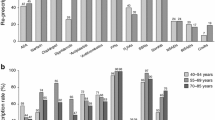Abstract
Objective
This population-based survey was conducted to provide a formal description of upper gastrointestinal bleeding (UGIB) in children on a nationwide basis and assess the contribution of risk factors, principally nonsteroidal anti-inflammatory drugs (NSAID).
Methods
A case-crossover study of UGIB patients aged between 2 months and 16 years was conducted in France. Medical data were collected by physicians, and personal risk factors and exposure to drugs during the month preceding the onset of the bleeding was ascertained by a standardised telephone interview with parents. The odds ratios for UGIB and NSAID was assessed by comparing exposure during the 7 days preceding the date of hospitalisation and the 21st to the 28th days before that date.
Results
A total of 177 children with UGIB were included over 2 years. Eighty-three children had taken at least one NSAID before the index date, among which 58 were ibuprofen, 26 aspirin and nine others. The adjusted odds ratio (OR) of exposure was 8.2 [95% confidence interval (CI) 2.6–26.0] for NSAIDs altogether, and this was 10.0 (95% CI 2.0–51.0) for ibuprofen and 7.3 (95% CI 0.9–59.4) for aspirin. There was no increased risk associated with NSAIDS for oesophageal lesion [OR = 1.0 [(5% CI:0.2–7.2)].
Conclusion
The study confirms that UGIB is rare but that some cases may be avoided, as one third of the cases was attributable to exposure to NSAID at doses used for analgesic or antipyretic purposes, which may be attained with alternative therapy. The findings from this study call for more caution in prescribing NSAIDS to children.
Similar content being viewed by others
References
Laine L (2004) Proton pump inhibitor co-therapy with nonsteroidal anti-inflammatory drugs-nice or necessary? Rev Gastroenterol Disord 4(Suppl 4):S33–S41
Van Leerdam ME (2008) Epidemiology of acute upper gastrointestinal bleeding. Best Pract Res Clin Gastroenterol 22(2):209–224
Hollenz M, Stolte M, Leodolter A, Labenz J (2006) NSAID-associated dyspepsia and ulcers: a prospective cohort study in primary care. Dig Dis 24(1–2):189–194
Cagnoni PJ, Aledort L (1994) Gastrointestinal bleeding in hemophilia as a complication of the use of over the counter non-steroidal anti-inflammatory drugs. Am J Hematol 47:336–337
Fox VL (2000) Gastrointestinal bleeding in infancy and childhood. Gastroenterol Clin North Am 29(1):37–66
Mouterde O, Hadji S, Mallet E, Le Luyer B, Metayer P (1996) Les hémorragies digestives chez l’enfant, à propos de 485 endoscopies. Ann Pédiatr 43:167–176
Keenan GF, Giannini EH, Athreya BH (1995) Clinically significant gastropathy associated with nonsteroidal antiinflammatory drug use in children with juvenile rheumatoid arthritis. J Rheumatol 22(6):1149–1151
Titchen T, Cranswick N, Beggs S (2005) Adverse drug reactions to nonsteroidal anti-inflammatory drugs, COX-2 inhibitors and paracetamol in a paediatric hospital. Br J Clin Pharmacol 59(6):718–723
Lesko SM, Mitchell AA (1995) An assessment of the safety of pediatric ibuprofen. A practitioner-based randomized clinical trial. JAMA 273(12):929–933
Garcia Rodriguez LA, Hernandez-Diaz S (2001) Relative risk of upper gastrointestinal complications among users of acetaminophen and nonsteroïdal anti-inflammatory drugs. Epidemiology 12(5):570–576
Maclure M (1991) The case-crossover design: a method for studying transient effects on the risk of acute events. Am J Epidemiol 133(2):144–153
Holvoet J, Terriere L, Van Hee W, Verbist L, Fierens E, Hautekeete ML (1191) Relation of uppergastrointestinal bleeding to non-steroidal anti-inflammatory drugs and aspirin: a case-control study. Gut 32(7):730–734
Laporte JR, Ibanez L, Vidal X, Vendrell L, Leone R (2004) Upper gastrointestinal bleeding associated with the use of NSAIDs: newer versus older agents. Drug Saf 27(6):411–420
Gutthann SP, Garcia Rodriguez LA, Raiford DS (1997) Individual non-steroidal anti-inflammatory drugs and other risk factors for upper gastrointestinal bleeding and perforation. Epidemiology 8(1):18–24
DeStefano F, Verstraeten T, Jackson LA, Okoro CA, Benson P, Black SB, Shinefield HR, Mullooly JP, Likosky W, Chen RT (2003) Vaccinations and risk of central nervous system demyelinating diseases in adults. Arch Neurol 60:504–509
Viboud C, Boëlle PY, Kelly J, Auquier A, Schlingmann J, Roujeau JC, Flahault A (2001) Comparison of the statistical efficiency of case-crossover and case-control designs: Application to severe cutaneous adverse reactions. J Clin Epidemiol 54:1218–1227
Etienney I, Beaugerie L, Viboud C, Flahault A (2003) Non-steroidal anti-inflammatory drugs as a risk factor for acute diarrhoea: a case crossover study. Gut 52:260–263
Levy M, Miller DR, Kaufman DW, Siskind V, Schwingl P, Rosenberg L, Strom B, Shapiro S (1988) Major upper gastrointestinal tract bleeding. Relation to the use of aspirin and other nonnarcotic analgesics. Arch Intern Med 148(2):281–285
Moride Y, Abenhaim L (1994) Evidence of the depletion of susceptibles effect in non-experimental pharmacoepidemiologic research. J Clin Epidemiol 47(7):731–737
Acknowledgements
The authors thank Richard Medeiros (Rouen University Hospital Medical Editor) for editing the manuscript.
Funds
This study was supported by research grants from the French Agency of Medical Security of Health Products (AFSSAPS).
Conflict of interest statements
None of the authors have financial or personal relationships, academic competition or intellectual commitments that might bias the work or interfere with objective judgment.
Access to data
Lamiae Grimaldi-Bensouda, Elisabeth Autret-Leca and Benoit David had full access to all data in the study and take responsibility for the integrity of the data and the accuracy of the data analysis.
Author information
Authors and Affiliations
Corresponding author
Rights and permissions
About this article
Cite this article
Grimaldi-Bensouda, L., Abenhaim, L., Michaud, L. et al. Clinical features and risk factors for upper gastrointestinal bleeding in children: a case-crossover study. Eur J Clin Pharmacol 66, 831–837 (2010). https://doi.org/10.1007/s00228-010-0832-3
Received:
Accepted:
Published:
Issue Date:
DOI: https://doi.org/10.1007/s00228-010-0832-3




